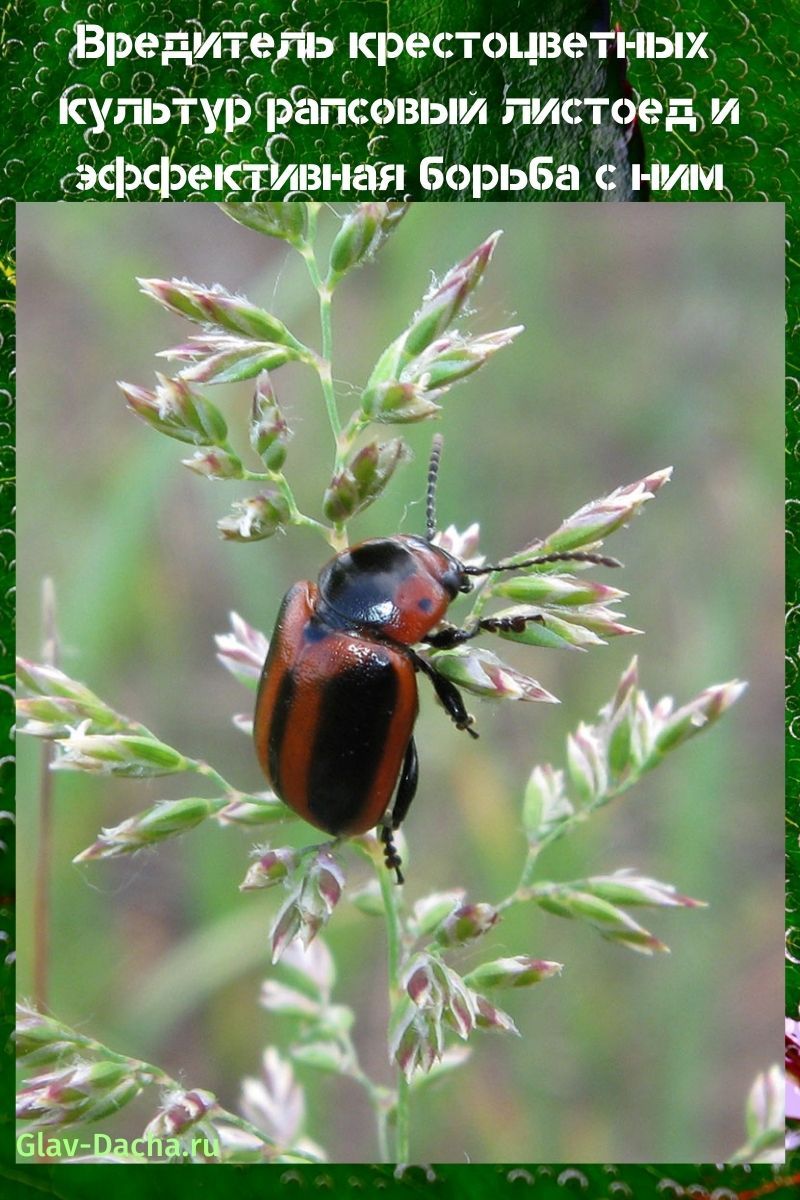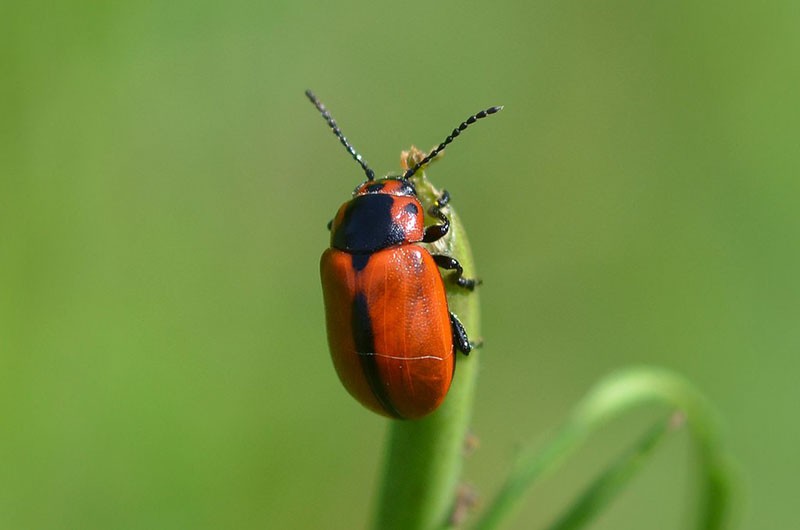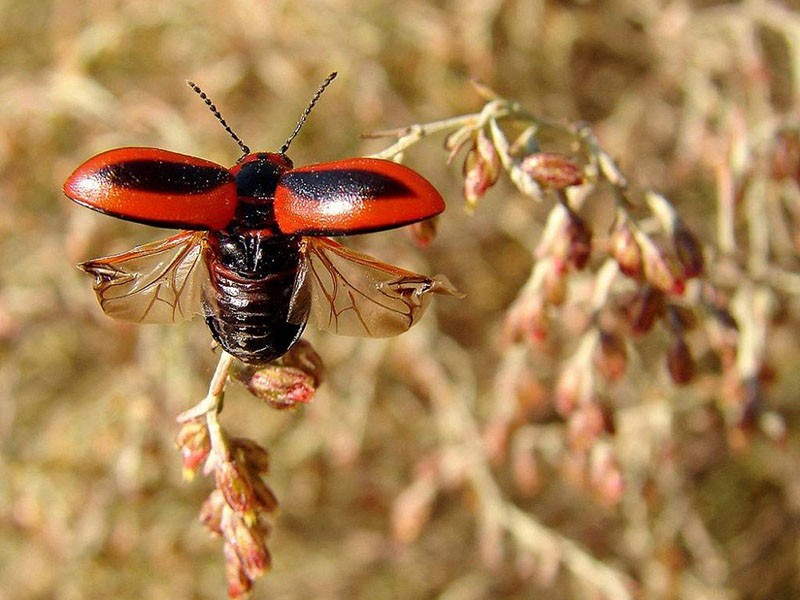Pest of cruciferous crops, rape leaf beetle and effective control of it
 Rapeseed beetle is one of the most common and dangerous pests of crops from the Cabbage family. This miniature bug is capable of causing tremendous harm to crops of rapeseed, mustard, turnip, turnip. The fight against the rapeseed beetle involves the use of affordable folk remedies, effective chemicals, as well as mandatory preventive measures.
Rapeseed beetle is one of the most common and dangerous pests of crops from the Cabbage family. This miniature bug is capable of causing tremendous harm to crops of rapeseed, mustard, turnip, turnip. The fight against the rapeseed beetle involves the use of affordable folk remedies, effective chemicals, as well as mandatory preventive measures.
Rape leaf beetle - pest description

The pest can be recognized by its characteristic features:
- The body of the beetle is oblong-oval, no more than 8-10 mm in size, covered with a chitinous membrane.
- The upper part of the body is colored red-black and has three longitudinal stripes - one of them is located along the suture and two on the right and left sides of the central part of the elytra.
- On the head of the insect there is a pair of black antennae, consisting of 11 segments.
- The canola beetle has six legs, thick and dense, also consisting of segments.
- The leaf beetle larva has a 12-16 mm body, brownish-brown color of the upper back and bright yellow color of the lower part of the body.
 Rapeseed pests cause serious damage to the vegetable garden. First, insects feed on cabbage weeds, and after an increase in the number of colonies, they affect white cabbage, radish, rapeseed, mustard.
Rapeseed pests cause serious damage to the vegetable garden. First, insects feed on cabbage weeds, and after an increase in the number of colonies, they affect white cabbage, radish, rapeseed, mustard.
Pests are both adults and leaf beetle larvae. They eat away the soft parts of plants, leaving only hard veins. This leads to the rapid death of cultivated plants and significantly reduces their productivity.
Rape leaf beetle control methods
 The fight against the rape leaf beetle is carried out in two ways - with the help of agrotechnical methods and chemicals. Many summer residents and gardeners use agrotechnical methods, as they have a more gentle effect and are completely safe for the future harvest. But it must be borne in mind that with a large number of pests, agricultural practices may be ineffective.
The fight against the rape leaf beetle is carried out in two ways - with the help of agrotechnical methods and chemicals. Many summer residents and gardeners use agrotechnical methods, as they have a more gentle effect and are completely safe for the future harvest. But it must be borne in mind that with a large number of pests, agricultural practices may be ineffective.
Agrotechnical methods
 Before you fight the leaf beetle with agrotechnical methods, you need to prepare the soil. In autumn, best of all in the first half of September, carefully dig up the soil. This will help to destroy the eggs of the rape beetle laid in the soil for the winter. This measure will stop the further spread of pests on the site.
Before you fight the leaf beetle with agrotechnical methods, you need to prepare the soil. In autumn, best of all in the first half of September, carefully dig up the soil. This will help to destroy the eggs of the rape beetle laid in the soil for the winter. This measure will stop the further spread of pests on the site.
Other agrotechnical control methods:
- Timely remove weeds on the site (especially from the Cruciferous family). They are food for beetles; in their absence, insects will be forced to leave the territory.
- Regularly loosen the soil between the plant beds - this will help to destroy the rape beetle pupae remaining in the ground.
- Early planting of cabbage seedlings, the use of greenhouses and greenhouses prevent pests from damaging the plantings.
Some gardeners use a little trick - they plant a small bed of rapeseed or cabbage, which will distract the pest from the main cultivated plants.
Rapeseed beetle and its larvae can be caught manually using a net. But this method is only suitable for pest control in a small area.
Chemicals
 You can start using chemicals if more than 10% of all green spaces are affected by the rape beetle or if there are at least 4-6 insects on one bush. In such cases, agrotechnical methods will be ineffective, it is possible to get rid of a large colony of parasites only with the help of chemicals.
You can start using chemicals if more than 10% of all green spaces are affected by the rape beetle or if there are at least 4-6 insects on one bush. In such cases, agrotechnical methods will be ineffective, it is possible to get rid of a large colony of parasites only with the help of chemicals.
Effective industrial remedies include:
- Zolon;
- Karbofos;
- Actellik;
- Metaphos;
- Phosbecid;
- Decis;
- Kemiphos.
These drugs belong to insecticides of intestinal and contact action. Their active substances, together with the treated leaves, enter the digestive system of the leaf beetle. Within a few hours, they cause disturbances in the transmission of nerve impulses, paralysis and death of pests. The protective effect lasts up to 15-25 days.
Any chemicals must be used in strict accordance with the manufacturer's instructions and at the indicated dosage.
 Treatment of affected plants is best done in the evening, after sunset. Most often at this time, the rape leaf beetle is selected on the surface of the leaves - this significantly increases the processing efficiency.
Treatment of affected plants is best done in the evening, after sunset. Most often at this time, the rape leaf beetle is selected on the surface of the leaves - this significantly increases the processing efficiency.
When the rape beetle appears in agricultural fields, 12% hexachlorane dust is used. The fields are pollinated with this powder in a proportion of 15-18 kg per 1 ha.
 Rapeseed beetle is a dangerous pest that causes serious harm to cruciferous plants. Combining simple and effective farming practices with modern chemicals will help get rid of insects and maintain high crop yields.
Rapeseed beetle is a dangerous pest that causes serious harm to cruciferous plants. Combining simple and effective farming practices with modern chemicals will help get rid of insects and maintain high crop yields.